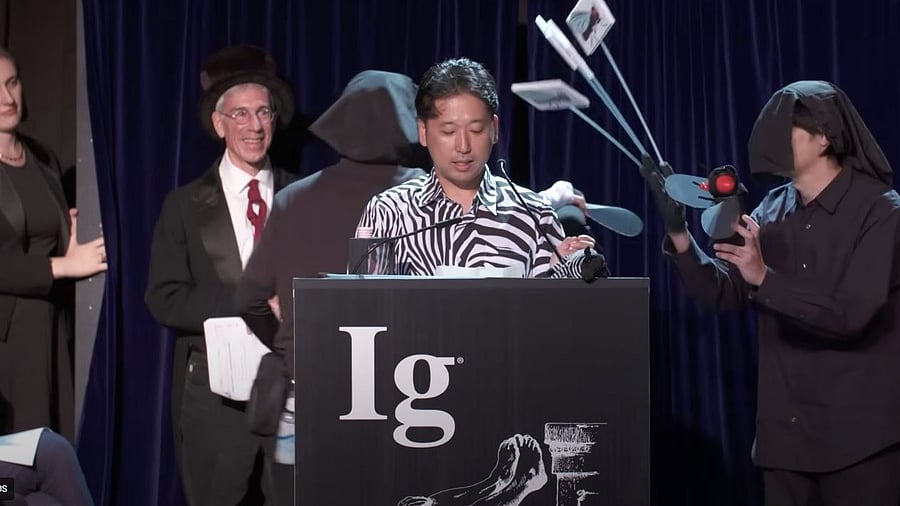
The Ig Noble Prize winners for the Biology category giving a speech.
Credit: YouTube/Improbable Research
As the Nobel Prize awards for 2025 begin this week, scheduled between October and December, September saw their satirical counterpart—the Ig Nobel Prizes—take centre stage. Drawing global attention, the Ig Nobels celebrated quirky and humorous takes on innovative thinking, handing out awards amid paper planes and playful experiments, all while aiming to spark public interest in science.
What is the Ig Nobel Prize?
First presented in 1991, the Ig Nobel Prize is a parody of the Nobel Prizes, following the motto: “to make people laugh, and then think.” Conceived by Marc Abrahams, founder of Improbable Research (which hosts the event), the awards honour unusual achievements that “cannot, or should not, be reproduced”—a light-hearted tribute to unconventional scientific efforts.
Each year, ten prizes are awarded in categories that mirror the Nobel Prizes. The twist? They are handed out by actual Nobel laureates, who revel in the playful spirit of the ceremony. The first awards were held at the MIT Museum in Cambridge, Massachusetts, before moving between MIT and Harvard University for several years. During the COVID-19 pandemic (2020–2023), the event was held online. This year, the ceremony returned in person, hosted at Boston University.
The name “Ig Nobel” is a pun on the word ignoble, meaning “base” or “unworthy.” While parodying the Nobel Prizes, the wordplay underscores the event’s purpose: to use humour as a way to engage audiences while prompting deeper reflection on science and innovation.
As the Nobel Prize awards for the year 2025 begin this week, scheduled from October to December, the month of September saw its satirical parallel Ig Nobel's presentation. Bringing global attention to the ceremony, the Ig Nobel Prizes commemorated humorous takes on innovative thinking, awarding the winners amongst paper planes and efforts to encourage public interest in the fields of science.
The 2025 Ig Nobel winners
The 35th edition of the Igs, conducted on September 18, brought forward some interesting findings, with the theme being 'Digestion'. With many events lined up for the ceremony, including a circus and an opera, the winners of this year are:
1. Aviation Prize: Awarded to Francisco Sánchez, Carmi Korine, Mariana Melcón, and Berry Pinshow for their study on whether ingesting alcohol can impair bats’ ability to fly and also their ability to echolocate.
2. Biology Prize: Awarded to Awarded to Kazato Oishi, Yasushi Matsubara, Yuki Uchiyama, Yoshihiko Fukushima, Tomoki Kojima, Say Sato, Tatsuaki Masuda, Junichi Ueda, Hiroyuki Hirooka, Naoto Aoki, and Katsutoshi Kino, for their experiments to understand whether cows painted with zebra-like stripes can avoid being bitten by flies.
3. Chemistry Prize: Awarded to Daniel Naftalovich, Rotem Naftalovich, and Frank Greenway, for experiments to test whether eating Teflon (a form of plastic) is a good way to increase food volume and hence satiety without increasing calorie content.
4. Engineering Prize: Sarthak Mittal and Vikash Kumar, for analyzing, from an engineering design perspective, how foul-smelling shoes can affect the experience of using a shoe-rack.
5. Literature Prize: Awarded to the late Dr William B Bean for his analysis on the rate of growth of one of his fingernails over a period of 35 years.
6. Nutrition Prize: Awarded to Gabriel H Segniagbeto, Roger Meek, Daniele Dendi, and Luca Luiselli, for studying the extent to which a certain kind of lizard chooses to eat certain types of pizza.
7. Peace Prize: Awarded to Fritz Renner, Inge Kersbergen, Matt Field, and Jessica Werthmann, for showing that drinking alcohol can sometimes improves an individual’s ability to speak in a foreign language.
8. Pediatrics Prize: Awarded to Gary Beauchamp and Julie Mennella, for study on what a nursing baby experiences when the baby’s mother eats garlic.
9. Physics Prize: Awarded to Giacomo Bartolucci, Daniel Maria Busiello, Matteo Ciarchi, Alberto Corticelli, Ivan Di Terlizzi, Fabrizio Olmeda, Davide Revignas, and Vincenzo Maria Schimmenti, for observations about the physics of pasta sauce, especially the phase transition that can lead to clumping.
10. Psychology Prize: Awarded to Gilles Gignac and Marcin Zajenkowski, for investigating what happens when you tell narcissists, or anyone else, that they are intelligent.
Fun facts about the Igs
The audience is invited to throw paper planes as the winners are announced, in a way honouring their contributions. A Miss Sweetie Poo is appointed as a human timer to remind the awardees as they keep their speeches quick, by saying, "Please stop. I’m bored. Please stop. I’m bored." Andre Geim remains the only person to win an Ig Nobel and a Nobel prize, both. In 200, he won the Ig Nobel prize for levitating a frog with magnets, and in 2010 he was awarded the Nobel Prize for research into the carbon compound graphene.
the Ig Nobel Prizes have always amused the globe, in a mission to encourage unique ideas in fields in and out of science. Till date, it continues to attract eyeballs as each research is applauded for its unique approach in contributing to thought.